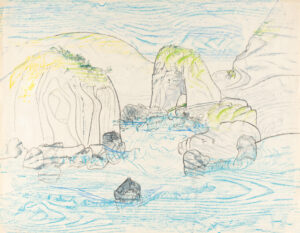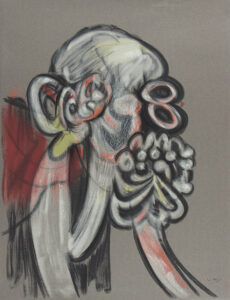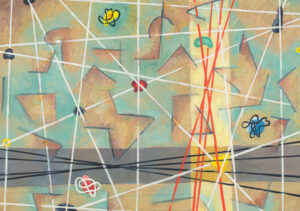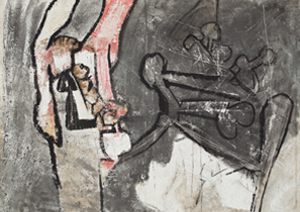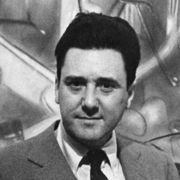
Roberto Matta
(1911-2002)
The Gallery works closely with the family of the artist Roberto Matta since 2018.
Roberto Sebastian Matta is a Chilean surrealist painter. Multilingual and a tireless traveller, he had a profound influence on his contemporaries, especially on Abstract Expressionist artists and he also rubbed shoulders with artists of the Cobra movement.
Exhibitions
Publications

ROBERTO MATTA
MANIFESTE ET VOUS
Catalog 80 pages – Texts by Thomas Baumgartner, Fariba Bogzaran, Pablo Cueco, Anaïd Demir, Anne Egger, Réjane d’Espirac, Aurélien Masson et Ramuntcho Matta

ROBERTO MATTA – ALAIN JOUFFROY
Correspondance 1952-1960
Published by ARTEOS & Galerie Diane de Polignac
256 pages – French / English
Book realized under the direction of Christian Demare
Authors: Bernard Blistène, Marine Nédélec & Ramuntcho Matta
29 € + shipping
Videos
Introduction to the exhibition “Roberto Matta: The Earths” by Ramuntcho Matta.
Artwork analysis
The years of training and early travels of the Chilean Painter
Roberto Matta (Roberto Sebastián Antonio Matta Echaurren) was born on November 11th, 1911 in Santiago da Chile. Scion of a family of notables originating from the Basque country, he was sent to French schools. Between 1929 and 1931, Matta started to study architecture at the Catholic University of Santiago. He was influenced there by the painter Hernan Gazmuri, a former pupil of André Lhote. Roberto Matta received his degree in 1935 and went to France. In Paris, he worked in Le Corbusier’s studio. The Chilean painter Roberto Matta travelled around Europe from the following year: Spain where he met the poets Rafael Alberti and Federico Garcia Lorca, Portugal where he met the poet Gabriela Mistral, Scandinavia where he met the architect Alvar Aalto and London in 1836 where he met the artists Henry Moore, René Magritte, László Moholy-Nagy and Roland Penrose, as well as the architect Walter Gropius.
Roberto Matta in Paris: the Surrealist Years
Federico Garcia Lorca aroused in Roberto Matta a sensitivity to poetry. He also sent a letter to Salvador Dalí to put the two artists in touch. Lorca was assassinated the following year by pro-Franco forces. His death was one of the determining factors in stirring the Chilean artist’s political conscience.
Dalí had a strong influence on the formation of Roberto Matta. He encouraged the Chilean to show his drawings to André Breton and exhibited them in 1937 at the Galerie Gradiva. André Breton then agreed to include Matta in the Surrealist group. Matta soon appropriated their themes for himself: the unconscious, automatism, poetic inspiration, eroticism, revolutionary engagement and the search for a new future for humanity. André Breton described the Chilean artist: “one of the most promising recruits for the Surrealists. In him, nothing is directed, nothing that does not result from the desire to deepen the faculty of divination by means of colour, a faculty at which he is exceptionally talented.”
The same year, Roberto Matta was employed as architect for the Spanish pavilion at the l’Exposition international of Paris. This provided an opportunity to meet Picasso who was working on Guernica and this painting had a profound effect on him aesthetically. Matta also saw the works of Marcel Duchamp for the first time and met him shortly afterwards. Duchamp said of Matta that he was “the most profound artist of his generation.” In 1938, Roberto Matta participated in the Exposition Internationale du Surréalisme at the Galerie des Beaux-Arts. He married Ann Clark from America, with whom he had twins in 1943: Gordon Matta-Clark and John Sebastian Matta.
In the summer of 1939, Matta stayed at the Château de Chemillieu in the Ain département, rented by his friend the painter Gordon Onslow Ford. It is apparently at this time that Ford lent him his materials, encouraging him to move from drawing to painting. Roberto Matta then painted his first canvas. The two friends were joined by the painters Esteban Francés, Yves Tanguy and Kay Sage, and by André and Jacqueline Breton. Matta then painted his series of Psychological Morphologies with which he tried out a new technique: colour was spread onto the canvas with a cloth and the brush was then used to create lines on the colour which was already in place. This process was inspired by the automatic writing practiced with his Surrealist friends. These canvases offered graphic translations of the psyche, fluxes that circulated in the world between humans and things. This series of Psychological Morphologies recalls Breton’s surrealist injunction: “The work of art, to respond to the absolute need for revision of real values on which all minds agree today, will therefore refer to a purely internal model, or won’t.” The group returned to Paris in September when France and Britain declared war on Germany.
The Surrealist Painter in the USA: Encounter with Abstract Expressionism
Fleeing from war, Duchamp and Matta went to New York together. Both artists were represented there by the Julien Levy Gallery. The American dealer was the great defender of the Surrealists in the USA. He said about Roberto Matta: “He seemed to be haunted by space, which he could render vast and inhuman… His epics were sometimes horrible, sometimes coldly glorious, but always torn by the passions of physics that wanted to be become biology.” Julien Lévy also represented Salvador Dali, Arshile Gorky, Frida Kahlo, Man Ray and Yves Tanguy.
Scientific publications fascinated Robert Matta: he was inspired by discoveries in the physics of relativity and the theories about the fourth dimension. He also experimented with phosphorescent pigments to create works that changed with variations in light. After a first rather abstract period, Roberto Matta introduced the human figure to his works from the 1940s. His paintings then essentially treated the dialogue between humans and machines.
He also gave lectures at the New School of Social Research and received many young Americans in his studio such as Jackson Pollock and Arshile Gorky. He would say to them: “you paint on an easel, you are still painting what you see. You need to put the canvas on the ground and paint what you feel.” He made them practice “absolute automatism”.
Roberto Matta illustrated Denis de Rougemont’s Lettres sur la bombe atomique which was published by Brentano’s in New York in 1946. He was also a close friend of Robert Motherwell.
Roberto Matta’s many trips and encounters are known from his correspondence. These documents allow us to underline his multilingual abilities as he jungled between four languages: Spanish, French, English and Italian. He used his ability to create puns in the surrealist vein. He is also one of the rare Surrealist artists with Marcel Duchamp to have spoken English, which explains his major influence on American Abstract Expressionist artists.
During the summer of 1941, Matta went to Mexico with his friend Robert Motherwell and became conscious of the “terrifying power of the land”. This strong impression inspired a series of “chaoscosmic” works which he created between 1941 and 1943. Roberto Matta also witnessed a volcano erupting and in 1987 recounted how this marked his process and his works afterwards: “It’s by chance that my work began to take on the shapes of volcanos, the way I treated the flame led me there. I saw everything enflamed, but from a metaphysical point of view, I spoke about the volcano’s afterlife. The light was not a surface that reflected the source of light, but an internal fire. Only feelings that hurt are visible. I painted what burned me and the best image of my body was the volcano.”
In 1941, Roberto Matta’s works were exhibited in Pierre Matisse’s New York gallery and at the Art Institute of Chicago with Wilfredo Lam. In 1943, the Surrealist painter participated in a group show at Peggy Guggenheim’s Art of this Century Gallery and then in 1944, he was included in Abstract and Surrealist Art in the United States, a travelling exhibition that was circulated from Cincinnati to San Francisco.
Roberto Matta bought a plaster work by Giacometti and began to collect “primitive” art. He married Patricia O’Connors in Los Angeles.
Roberto Matta in Latin America: the Political Years of the Chilean Painter
Accused of provoking the suicide of Arshile Gorky by having an affair with his wife, Robert Matta had to leave New York in 1947. He returned to Paris where he was excluded from the Surrealist group for the same reason in October 1948. A group of friends that defended him then gathered around him: the artists Francis Bouvet, Victor Brauner and Claude Tarnaud, and the writers Sarane Alexandrian, Alain Jouffroy and Stanislas Rodanski. Sarane Alexandrian called the group the “Counter-Group H”: an unorthodox form of surrealism united around the magazine Néon.
Roberto Matta’s first solo exhibition was held in Paris in 1947 at the Galerie René Drouin. He also exhibited at the Venice Biennale and the Wiliam Copley Gallery in Beverly Hills.
Roberto Matta then returned to Chile. He published a text emphasizing the “role of the revolutionary artist, who must rediscover new emotional relations between men.” In fact, Matta’s political activism took on an important role in his work. He then returned to Europe. From 1950 to 1953, Roberto Matta lived in Italy with the Sicilian actress Angela Faranda between Sicily, Rome and Venice. It was in Rome, during 1952, that he strengthened his friendship with Alain Jouffroy. Jouffroy wrote about this trip in Le Roman vécu: “In Spring 1952, he invited me to Rome. I spent three months there that I cannot describe in any other way than by the word incandescent. Matta’s friendship saved me definitively from the idea of misfortune and rejection, because it freed the energy that can dominate failure and pain. Roberto Matta and Angela Faranda were married in 1950; a son was born the following year: Pablo Echaurren.
In 1952, the Chilean painter created a painting about a historical event for the first time: the trial of the Rosenberg couple, accused in the USA of spying for the Russians. Jouffroy referred to it in Le Roman Vécu “very quickly the trial of Julius and Ethel Rosenberg, which scandalized us, became our central political preoccupation.” This work opens a new period in Matta’s development as a painter, devoted to a metaphorical interpretation of History and the representation of the conflicts that would continue during the second half of the 20th century.
The Italian Terres and Roberto Matta’s contact with the Cobra movement
In 1952, the painter Roberto Matta showed at the Sao Paolo Biennale and the same year won a prize at the Pittsburgh International Exhibition of Contemporary Paintings.
From December 1952, Matta was under contract with Carlo Cardazzo, a gallerist based in Venice and Milan. In Venice, he met the American collector and patron Peggy Guggenheim and her daughter Pegeen Vail Guggenheim. In 1953, Matta was in Paris. The same year, the Galleria del Cavallino at the Sala Napoleonica organized an exhibition for Matta in Venice. In 1954, back in Rome, Matta met Malitte Pope, an American woman born in 1928 who worked in fashion. They married and had two children: Federica (1955) and Ramuntcho (1960).
After Rome, Roberto Matta returned to Paris at the end of 1954. The publisher and the gallery Les Cahiers d’Art of Christian Zervos commissioned cover designs from Matta.
In 1954, Matta began to visit Albisola for gatherings around ceramics organized by Asger Jorn in the studio of Giuseppe Mazzotti, with Enrico Baj, Corneille, Sergio Dangelo and Édouard Jaguer among others. It was in Albisola that Matta used earth for the first time. Then, from ceramics he evolved towards painting, integrating earth directly as a raw material. These meetings allowed the Chilean surrealist painter to work with artists from the Cobra movement.
From December 1954 to February 1955, Roberto Matta was in New York and Chicago. The gallerists Allan Frumkin and Alexandre Iolas exhibited his works in these two American cities. His success in the USA reached a peak in 1957 with a solo exhibition entitled Matta at the Museum of Modern Art of New York. Roberto Matta then exhibited regularly in the USA, at the Walker Art Center Minneapolis in 1967, at the Andrew Crispo Gallery in New York during 1975, at the Tasende Gallery in La Jolla, California in 1980, at the Blanden Memorial Art Gallery of Fort Dodge in 1981 and the Yares Gallery Scottsdale during 1985.
He again left the USA to settle in Italy, first at Ischia, a volcanic island off the coast of Naples where he met the painter Leonardo Cremonini. In 1957, Malitte and Roberto Matta bought a house at Panarea in the archipelago of the Aeolian Islands. They began renovation work and Matta apparently paid the workers with paintings made from the soil of Panarea. Earth, discovered with ceramics, was therefore included in Roberto Matta’s works as a painter. The large anthropomorphic forms that had appeared in his paintings during the 1940s resurfaced in his Terres. At the start of the 1960s, several exhibitions showed Terres: Un trittico ed altri dipinti at the L’Attico gallery of Rome in 1962 and Matta, Mostra personale, at the Galleria Schwarz, Milan in 1963. The Italian philosopher Italo Calvino write in the exhibition catalogue: “a happy season of work in Italy and the encounter with a material rich in elementary suggestiveness, a reddish earth from the Roman countryside: all this is the source of these almost monochromatic paintings, where frescoes between the prehistorical, the totemic and the science-fiction agitate as if they were guided by the sound of a subterranean saxophone.”
The Surrealist Painter and the Terres of Cuba
Earth is also used as a raw material in the paintings created during Matta’s visits to Cuba from 1963. His last wife, Germana Ferrari explained in her text “A la ‘Casa de la Americas’”, that Matta changed the traditional tools and materials of painters, forced by necessity and the “absence of canvas, oil colours and thin paintbrushes” in revolutionary Cuba. So he used “brushes of house painters and their powder colours sold by the kilo to paint houses.” Then, “instead of linen canvas, he stretched hessian canvas from bags for cane sugar onto stretchers”. And finally, “he mixed the earth from the garden like a mason, with lime, water.”
In May 1964, Matta exhibited paintings made with earth from Cuba at the Galleria L’Attico in Rome. The return to the origins and the primordial nature of humanity is always present when Matta uses earth as the theme or an independent material.
With his Terres, Matta’s intention was to depict a morphology of humanity in relation with itself, others and the world, he spoke about “historical morphology”. The Terres are in fact primarily connected to the places where they were made. Then beyond the places themselves, the subjects of the Terres are in some cases directly political. This is the case for La Question, Djamila, painted as a tribute to the book by Henri Alleg retracing the torture suffered by this communist activist in 1957 during the Algerian war.
Matta received the Marzotto prize in 1962 for this painting. His art in the 1960s was profoundly political. Alain Jouffroy explained this in 1960 in his article Pour un art révolutionnaire indépendant: “it is that, beyond any moral or aesthetic consideration, Matta has always appeared to me to be the most revolutionary and most independent of painters and that his personal way of resolving the contradiction that exists in living on a world that we are fighting is in my view exemplary.”
Earth also served as a pigment in the series from the 1970s that Matta devoted to Christ. It was shown in 1974 at Terni, in Italy, with the title Bella Ciao. Matta wanted “to connect Bella Ciao to the history of the human being.”
The Mature years of Roberto Matta: the Return to France
Matta was reintegrated into the Surrealist group in 1957 during the ceremony of the Exécution du Testament du Marquis de Sade of Jean Benoît.
In 1968, Matta covered the walls and ceilings of the Musée d’Art Moderne de Paris with paintings. This installation was an expression of Matta’s experimentation with “the open cube”. The space of the painting was no longer thought of as a flat surface, but as a volume in three dimensions. It is the physical description of the painting-chamber, the work occupies its amplitude in space. Matta offered an artistic space that can “give an image of the amplitude of the conscience in the form of the six sides of a cube”. The following year, Matta and Germana had a daughter Alisée Matta.
In 1968, Roberto Matta participated in the first cultural congress in Havana in Cuba. He exhibited several times in Latin America, especially at the Lima Instituto de Arte Contemporáneo in Peru in 1966 and at the Museo de Arte Moderno in Mexico City in 1975. After General Pinochet’s coup d’état in Chile on 11 September 1973, Roberto Matta definitively cut off all connections with his native country: “it is this exile that determined my entire life, between two cultures. My work is a work of separation. […] From exile I moved to the “Exile”, somewhere between the known and the unknown, between reality and the imaginary. Where poetry begins.” In 1974, he participated in the Venice Biennale with the theme theme For a democratic and anti-fascist culture. Matta was deprived of his Chilean nationality that year and gradually abandoned political causes.
Roberto Matta obtained French nationality in 1979 and married Germana Ferrari the following year. In 1984, the Galerie Samy Kinge organized the exhibition Matta. Point d’appui. Helped by his son Ramuntcho, Matta produced a dozen short films for French television. In 1985, the Center Pompidou in Paris held a major retrospective of his work.
Roberto Matta was also exhibited in Asia: at the Hara Museum of Contemporary Art in 1986 and at the Fuji Television Gallery in Tokyo in 1993 and at the Yokohama Museum of Art in 1994. In 1990, the Chilean government awarded the Premio national de arte prize to Matta. The following year a retrospective exhibition of his work was held at the Museo Nacional de Bellas Artes of Santiago and then at the Fundacion Museo de Bellas Artes of Caracas. In 1996, an enormous fresco in ceramic was inaugurated in the Quinta Normal metro station in Santiago de Chile. In 2000, Roberto Matta exhibited at the Robert Elkon Gallery in New York. The following year a travelling exhibition Matta in America. Paintings and Drawings of the 1940’s was shown at the Museum of Contemporary Art, Los Angeles, the Miami Art Museum and the Museum of Contemporary Art in Chicago.
The surrealist painter Roberto Matta died on November 23rd, 2002 at Civitavecchia in Italy. The president of Chile, Ricardo Lagos Escobar decreed national mourning for three days.
© Diane de Polignac Gallery / Mathilde Gubanski
Translation: Jane Mac Avock

Roberto Matta in his studio, Paris, c. 1956
SELECTED PUBLIC COLLECTIONS
Selected public collections
Amsterdam, Stedelijk Museum
Baltimore, Baltimore Museum of Art
Brussels, Musée Royaux des Beaux-Arts de Belgique
Cambridge, MA, Harvard Art Museum,
Chicago, Art Institute of Chicago
Chicago, Museum of Contemporary Art Chicago
Chicago, Smart Museum of Art, University of Chicago
Cleveland, Cleveland Museum of Art
Haifa, Haifa Museum of Art
Houston, The Menil Collection
Houston, The Museum of Fine Arts
Indianapolis, Indianapolis Museum of Art
London, Tate Modern
Los Angeles, Los Angeles County Museum of Art (LACMA)
Madrid, Museo Reina Sofia
Madrid, Museo Nacional Thyssen-Bornemisza
Mexico City, Museo Tamayo
Milwaukee, Milwaukee Art Museum
New Heaven, Yale University Art Gallery
New York, Solomon R. Guggenheim Museum
New York, Museum of Modern Art
New York, Metropolitan Museum of Art
New York, Whitney Museum of American Art
Paris, Musée d’Art Moderne de la Ville de Paris
Paris, Centre Pompidou
Philadelphia, Philadelphia Museum of Art
Pittsburgh, Carnegie Museum of Art
Poughkeepsie, Frances Lehman Loeb Art Center – Vassar College
Princeton, Princeton University Art Museum
Providence, Museum of Art, Rhode Island School of Design
Saint Louis, Saint Louis Art Museum
San Francisco, San Francisco Museum of Modern Art
Santiago, Centro Cultural Palacio La Moneda
Santiago, Museo de la Solidaridad Salvador Allende
Stockholm, Moderna Museet
Tel-Aviv-Yafo, Musée d’Art Moderne de Tel Aviv
Williamstown, Williams College Museum of Art
SELECTED EXHIBITIONS
Selected exhibitions
Exposition internationale du surréalisme, Galerie des Beaux-Arts, Paris, 1938
Exposición internacional del Surrealismo, Galeria de Arte Mexicano, Mexico City, 1939
Julien Levy Gallery, New York, 1940, 1943, 1945
Surrealism To-Day, Zwemmer Gallery, London, 1940
Pierre Matisse Gallery, New York, 1941, 1942, 1944, 1945, 1948
The Art Institute, Chicago, 1941
Art of this Century Gallery, Peggy Guggenheim, New York, 1943
Museum of Modern Art, New York, 1947, 1957, 2004
Matta, Galerie René Drouin, Paris, 1947, 1949
Venice Biennale, 1948, 1974
Galleria dell’Obelisco, Rome, 1950, 1954
Matta, Museum of Art, San Francisco, 1950
Matta, Institute of Contemporary Art, London, 1951
Musée National d’Art Moderne, Paris, 1952, 1967, 1968
Dessins de Matta, Galerie Nina Dausset, Paris, 1952
Matta. New Works, Allan Frumkin Gallery, Chicago, 1952, 1959, 1961, 1964
Alexander Iolas Gallery, New York, 1953, 1959, 1961, 1973, 1975
Matta, Museo Nacional de Bellas Artes, Santiago de Chili, 1954, 1991
Guggenheim Museum, New York, 1954, 1961
Salon de Mai, Paris, 1954
Sao Paulo Biennale, 1955
Galerie du Dragon, Paris, 1956, 1958, 1962, 1963, 1978
Galerie Daniel Cordier, Paris, 1956, 1961
Walker Art Center, Minneapolis, 1957, 1966
Institute of Contemporary Art, Boston, 1957
Matta, Fundacion Eugenio Mendoza, Caracas, 1957
Matta, Galleria Nazionale d’Arte Moderna, Rome, 1957
Matta, Moderna Museet, Stockholm, 1958
Galerie Daniel Cordier, Frankfurt, 1959, 1961
Moderna Museet, Stockholm, 1959, 1970
Documenta, Kassel, 1959, 1964
Musée des Arts décoratifs, Paris, 1960, 1987
Matta, M.H. de Young Memorial Museum, San Francisco, 1963
Matta, Franck Perls Gallery, Los Angeles, 1963
Museo Civico, Bologna, 1963
Museum des 20. Jahrhunderts, Vienna, 1963
Kunstverein für die Rheinlande Westfalen, Düsseldorf, 1963
Stedelijk Museum, Amsterdam, 1963
Palais des Beaux-Arts, Brusels, 1963, 1964
Museo Nacional de Bellas Artes, Havana, 1964, 1967, 1976, 1983
Casa de las Americas, Cuba, 1964
Sebastian Matta. Voices, Wittenborn Gallery, New York, 1965
Matta. Le Honni aveuglant, Galerie Alexandre Iolas, Paris, 1966
Matta. El Cubo abierto, Instituto de Arte Contemporaneo, Lima, 1966
Matta. Œuvres récentes, Galerie Maya, Brussels, 1970
Matta, Nationalgalerie, Staatliche Museen Preussischer Kulturbesitz, Berlin, 1970
Matta. L’art de Noé, Palazzo Durini, Milan, 1974
Museo de Arte Moderno, Mexico City, 1974
Museo de Arte Moderno, Bogota, 1974, 1975
Museo de Bellas Artes, Caracas, 1974, 1991
Galleria dell’Oca, Rome, 1975, 1976
Matta. Coigitum, Hayward Gallery, London, 1977
Matta. Oleos Recientes, Galeria Minotauro, Caracas, 1978
La Araucana, Stamperia della Bezuga, Florence, 1979
Galerie Samy Kinge, Paris, 1980, 1981, 1984
Matta. Graphics, American Academy of Rome, Rome, 1981
Matta. Storming the Tempest, Riverside Studios, London, 1982
Museum of Art, Fort Lauderdale, 1983
Center for Inter-American Relations, New York, 1983
Palacio de Cristal, Madrid, 1983
Circulo de Bellas Artes, Ministerio de Cultura, Madrid, 1983
Museo de Bellas Artes, Bilbao, 1983
Fuji Television Gallery, Tokyo, 1985, 1993, 1997
Matta, Centre Pompidou, Paris, 1985
Matta, Hara Museum of Contemporary Art, Tokyo, 1986
Matta, Palazzo Venezia, Rome, 1988
Matta, The Early Years, Maxwell Davidson Gallery, New York, 1988
Matta, Museo Nacional de Balles Artes, Santiago de Chili, 1989
Matta. Dessins 1936-1989, Galerie de France, Paris, 1990
Matta, Palazzo Reale, Milan, 1990
Matta, Kunsthalle der Hypo-Kulturstiftung, Munich, 1990
Kunsthaus, Vienna, 1990
Crosscurrents of Modernism. Four Latin American Pioneers: Diego Rivera, Joaquin Torres-Garcia, Wifredo Lam, Matta, Hirshhorn Museum and Sculpture Garden, Washington, 1992
Masson et Matta: les deux univers, Yokohama Museum of Art, Yokohama, 1994
Matta: Following the Footsteps of a Giant, Centro cultural Borges, Buenos Aires, 1998
Matta. Obra grafica, Fundacion Pablo Ruiz Picasso, Museo Casa Natal, Malaga, 1999
Museum of Contemporary Art, Los Angeles, 2001
Miami Art Museum, Miami, 2001
Museum of Contemporary Art, Chicago, 2001, 2002
Roberto Matta: le Grand Burundun, Musée d’Art Moderne et Contemporain, Geneva, 2002
Roberto Matta. Architect of Surrealism, Art Museum of the Americas, Washington DC, 2003
Transmission. The Art of Matta and Gordon Matta-Clark, Museum of Art, San Diego, 2006
The Human Image in the Twentieth Century. Works from the collection of the Tokushima Modern Art Museum, Tatsukichi Fuji Museum of Contemporary Art, Hekinan City, 2010
Don Qui. El Quijote de Matta, Instituto Cervantes, Madrid, 2011
Tremblement de ciel, Zanartu, Matta, Tellez, Maison de l’Amérique Latine, Paris, 2011
CasaMatta. Matta, opere inedite tra arte, design e artgianato, Triennale Design Museum, Milan, 2012
Alegria-Matta-Alegria, Casa de America Latina, Lisbon, 2012
Matta, Musée Cantini, Marseille, 2013
Matta – Les Terres, Galerie Diane de Polignac, Paris, 2018
Roberto Matta Manifeste et vous, Galerie Diane de Polignac, 2024
SELECTED BIBLIOGRAPHY
Selected bibliography
André Breton, Des tendances les plus récentes de la peinture surréaliste, (1939), in Le surréalisme et la peinture, followed by Genèse et perspective artistiques du surréalisme and by Fragments inédits, 2nd edition, revised and expanded, New-York, Brentano’s, 1945
André Breton, La perle est gâtée à mes yeux, 1944
Roberto Matta, Reorganimacion de la Afectividad, Pro Arte, año 1, n°24, Santiago, Chili, December 23rd, 1948
Alain Jouffroy, Attulima, illustrated by Roberto Matta, collection Naissance, Paris, La Balance, 1954
Marcel Jean, Matta ou le labyrinthe de verre, suivi de dix de dessins de Matta, Malheurs de ce temps, Les lettres nouvelles, n°63, Paris, éditions Julliard, September 1958
Patrick Waldberg, Matta, l’aube, le vertige, Quadrum, revue internationale d’art moderne, n°5, Brussels, 1958
Julien Alvard & Roberto Matta, Hypertension : la peinture murale de Matta, in dossier Les arts plastiques au nouveau siège de l’UNESCO, Quadrum, Revue internationale d’art moderne, n°6, Brussels, 1959
Raul Mellado, Matta: hay que despertar más conciencia del artista y del hombre, El Siglo, Chile, 6 February 1968
Alain Jouffroy, L’Abolition de l’art, illustrated with cartoons by Roberto Matta and five Plans d’Urgences de Daniel Pomereulle, Geneva, Edition C. Givaudan, 1968
Jean Schuster, Développement sur l’Infra-réalisme de Matta, collection Le Désordre, Paris, Eric Losfeld, 1970
Julien Levy, Memoir of an Art Gallery, New York, G.P. Putnam’s Sons, 1977
Germana Ferrari, Entretiens morphologiques-Notebook N°1, 1936-1944, Lugano, Sistan, 1987
Isabelle Bourrinet, Matta: Aux âmes Citoyens, TDC – Texts and documents for the class, June 1st, 1988
Eduardo Carrasco, Matta. Conversaciones, Santiago de Chile, Editiones CESOC, 1987
Sylvie Ramond, Qui est Roberto Matta ? TDC – Texts and documents for the class, June 1st, 1988
Alain Jouffroy, Matta réveille 1991, Opus International, in André Breton et le surréalisme international, n°123-124, April-May 1991
Yves Tanguy, Lettres de loin: adressées à Marcel Jean, Paris, Le Dilettante, 1993
Lydia Harambourg, L’Ecole De Paris, 1945-1965 : Dictionnaire Des Peintres, Lausanne, Ides et Calendes, 1993
Alain Jouffroy, Matta, outre terre et mère, De l’individualisme révolutionnaire, followed by Le Gué and by Correspondance avec Philippe Sollers, collection tel, Paris, Gallimard, 1997
Jean Dausset, La Galerie du Dragon, in Clin d’œil à la vie: la grande aventure HLA, Paris, O. Jacob, 1998
Paul Haim, Matta: agiter l’œil avant de voir : errances, souvenirs et autres divagations, Paris, Séguier, 2001
Eduardo Carrasco, Autorretrato, Nuevas conversaciones con Matta, Lorn, Santiago, 2002
Alain Jouffroy, Le réalisme ouvert de Matta et La Question de Matta, in Une révolution du regard, expanded edition, Paris, Gallimard, 2008
Jean-Jacques Lebel, Matta l’Emmerdeur, in A pied, à cheval et en Spoutnik: quelques écrits 1961-2009, collection Ecrits d’artistes, Paris, éditions de l’École Nationale Supérieure des Beaux-Arts de Paris, 2009
Roberto Matta, Notebook 1943, fac-similé du carnet de Matta de 1943, MAAT Editions, s.l., 2010
Lydia Harambourg, L’École de Paris, 1945-1965, Dictionnaire des peintres, Ides et Calendes, Neuchâtel, 1993, (update by Clotilde Scordia, Ides et Calendes, Neuchâtel, 2010)
Bernard Blistène, Ramuntcho Matta & Marine Nedelec, Roberto Matta – Alain Jouffroy, Correspondance 1952-1960, Paris, ARTEOS & Galerie Diane de Polignac, 2018
Roberto Matta Manifeste et vous, exhibition cat., Galerie Diane de Polignac, 2024
Roberto Matta Faq
On the ROBERTO MATTA FAQ page, find all the questions and answers dedicated to the modern art painter Roberto Matta.
